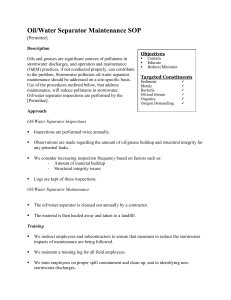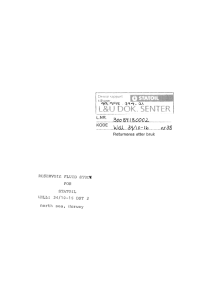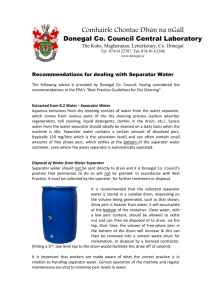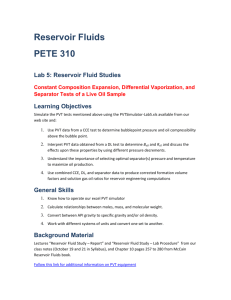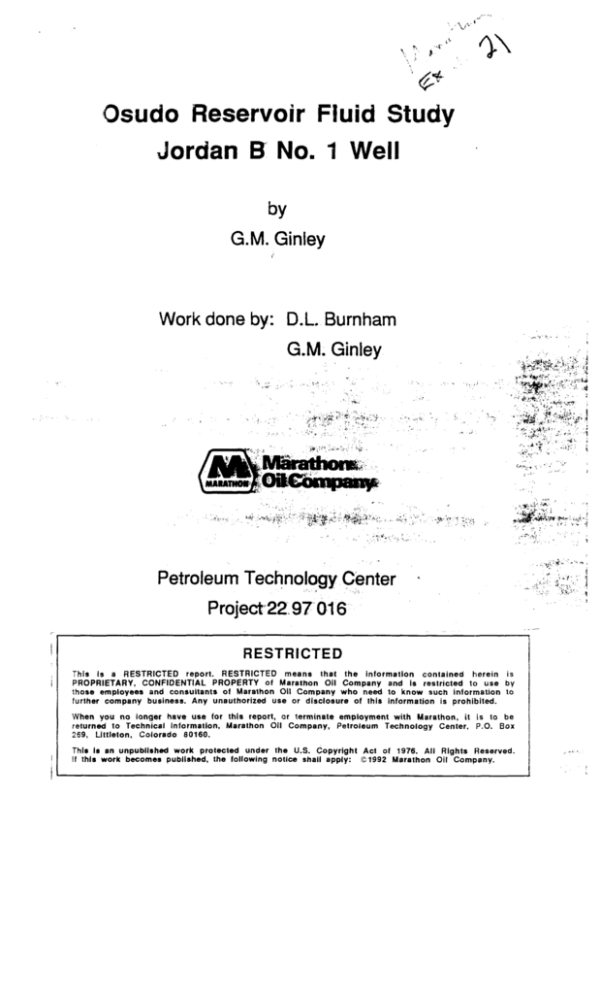
Osudo Reservoir Fluid Study
Jordan B No. 1 Well
by
G.M. Ginley
Work done by: D.L Burnham
G.M. Ginley
Petroleum Technology Center
Project 22 97 016
RESTRICTED
This is a RESTRICTED report. RESTRICTED means that the i n f o r m a t i o n c o n t a i n e d herein is
PROPRIETARY, CONFIDENTIAL PROPERTY of Marathon Oil Company and is restricted to use by
those employees and consultants of Marathon Oil Company w h o need to know such information lo
further company business. Any unauthorized use or disclosure of this information is prohibited.
When you no longer have use for this report, or terminate employment with Marathon, it is to be
returned to Technical Information, Marathon Oil Company, Petroleum Technology Center. P.O. Box
269, Littleton, Colorado 80160.
This is an unpublished work protected under the U.S. Copyright Act of 1976. All Rights Reserved.
If this work becomes published, the following notice shall apply: ©1992 Marathon Oil Company.
TABLE OF CONTENTS
Table of Contents
Summary
1
Table 1
Field Data for Reservoir Fluid Study
4
Table 2
Separator Gas Composition
5
Table 3
Separator Liquid Composition
6
Table 4
GOR Determination
7
Table 5
Second Stage Separator Liquid Flashed
to 12 psia and 90°F
8
Table 6
Recombined Fluid Composition
9
Table 7
Properties of Recombined Fluid
10
Table 8
Pressure Volume Relations at 152°F
Constant Composition Expansion
Constant Volume Depletion Study at 152°F
Compositions of Produced Wellstreams-Mole Percent
Liquid Dropout
Table 9
Table 10
11
.12
Constant Volume Depletion at 152°F
1
Figure 1
Schematic of Separator Scheme
1
Figure 2
Relative Volume
1
Figure 3
Compressibility Factor (z)
1
Figure 4
Liquid Dropout Curve
Figure 5
Distribution
Constant Composition Expansion
1
Liquid Dropout Curves
1
1
R e s e r v o i r Fluid Study
Jordan " B " No. 1 Well
Osudo Reservoir
L e a County, New Mexico
A reservoir fluid study was performed on first stage separator gas and liquid samples
taken from the Jordan "B" No. 1 well. This report contains the following results:
(1) Summary of sampling conditions.
(2) Compositional analysis of the first stage separator gas and first stage separator
liquid.
(3) Discussion of field separator scheme and procedure used to calculate the first
stage gas oil ratio.
(4) Recombination of separator fluids.
(5) Data obtained from a constant composition expansion (CCE) study of the
recombined fluid.
(6) Data obtained from a constant volume depletion (CVD) study of the recombined
fluid.
(7) Comparison between Core Laboratory data and PTC data.
Sampling Conditions
Separator gas and liquid samples were obtained from the subject well on June 17,
1992 by a representative of Core Laboratories. Reported field and sampling data are
given in Table 1. This data is directly from S. M. Posey, Midland or from the Core
Laboratory sampling documentation. Samples were received at PTC on June 25,
1992.
Analysis of Fluid Compositions
The compositions of the separator fluids were analyzed using gas chromatography.
The molecular weights of components C6 - C14 are the values reported by Katz and
Firoozabadi for general petroleum fractions. The molecular weight of the C15+ fraction
is calculated using a three step procedure. First, the separator liquid is flashed to
atmospheric conditions. Then we measure the molecular weight, specific gravity, and
composition of the resulting liquid. The C15+ molecular weight is then calculated using
the fluid composition and overall molecular weight. The specific gravity for each carbon
number fraction is calculated using a constant Watson K factor of 11.920 for each frac1
1
Katz, D. L. and Firoozabadi, A., "Predicting Phase Behavior of Condensate/Crude-Oil Systems
Using Methane Interaction Coefficients", J. Pet. Tech., November 1978, pp. 1649-1655.
tion. The value of the Watson K factor is picked so that the calculated specific gravity of
the stabilized liquid matches the measured value. Table 2 shows the composition of
the separator gas. The separator liquid composition is given through C15 + in Table 3.
Calculation of First Stage Separator Gas Oil Ratio
Field measurements of the primary separator gas and liquid rates were not available.
Instead measurements were obtained for the stock tank oil rate, combined gas rate
from the three separators, and gas rate from the stock tank. A schematic diagram of the
separator scheme is given in Figure 1. We flashed a sample of separator liquid to the
low pressure separator conditions and then flashed the resulting liquid to stock tank
conditions. Information obtained from the flash was combined with density and
measured fluid compositions to obtain an actual primary gas oil ratio of 9217 scf
primary separator gas/bbl primary separator liquid. Table 4 gives a summary of the
data used to calculate the actual GOR. In performing these calculaitons, it was
assumed that all of the fluid flowed through the 2 stage high pressure separator. S. M.
Posey of Midland informed us that approximate 90% of the flow does go through this
separator.
Second stage separator liquid was flashed to 12 psia and 90°F. Table 5 gives the
properties of the resulting gas and liquid. The GOR reported in Table 5 varies from the
field stock tank GOR. The actual field ratio was used in calculating the primary
separator flow rates.
Recombination of First Stage Separator Fluids
The separator gas and liquid were recombined with a target GOR of 9217 scf sep
gas/bbl sep liquid. The actual GOR of the recombined fluid used by our lab in the
phase behavior experiments were 9179 scf sep gas/bbl sep liquid. Table 6 contains
the calculated composition of the recombined fluid used in the phase behavior experiments. Molecular weights and specific gravities of the plus fractions and the overall
fluid are given in Table 7.
Constant Composition Expansion
The recombined fluid was charged to the PVT cell at reservoir temperature (152°F) and
8428 psia. A constant composition expansion test was performed on the fluid. A visual
dew point pressure of 7213 psia was observed. This was the first point at which the
fluid remained "cloudy" after equilibration. At 6562 psia we first observed liquid
droplets. The first measurable amount of liquid occurred at 5713 psia.
Pressure-Volume relations of the reservoir fluid obtained during the CCE are
presented in Table 8. Figures 2 and 3 present the relative volume and compressibility
of the fluid as a function of pressure. Figure 4 shows the liquid dropout curve. The
liquid volume in this graph is expressed as a percent of the total volume at the current
cell pressure. This fluid system exhibits a very long tail on the liquid dropout curve.
There is a 1500 psi difference between the visual dew point pressure and the pressure
at which we obtained a measurable amount of liquid. We chose to begin the constant
volume depletion study at 5713 psia. Thus, the relative volume data in Table 8 are
reported relative to the volume at 5713 psia. You can easily recalculate the volumes
relative to the total volume at the visual dew point of 7213 psia if necessary. The data
presented in Figure 4 are shown as a percent of the total volume at the stated pressure.
2
Constant Volume Depletion
After completion of the CCE, the fluid was repressurized to 5713 psia. The cell volume
was increased until a pressure of 3912 psia was obtained. The fluids were equilibrated
and volume measurements were obtained. Then enough gas was removed while
maintaining 3912 psia pressure in the cell to return to the original volume at the dew
point pressure (5713 psia). This procedure was repeated at 2514, 2012, 1013 and 512
psia. The weight of gas removed was recorded for each depletion step. The composition of the gas obtained at each pressure was measured by gas chromatography.
Table 9 gives the measured gas compositions and calculated molecular weights,
densities, and compressibility factors. Also stated in Table 9 is the cumulative production as a percent of the initial moles present. Table 10 gives the measured liquid
volumes for the depletion steps as percent of the saturation volume. Figure 5 compares
the liquid volumes present during the constant composition expansion and the
constant volume depletion. The liquid volumes in this figure are expressed as a
percent of the saturation volume.
Comparison of PTC Data with Core Laboratory Data
At the start of our reservoir fluid study, there was some concern expressed about the
dew point pressure of approximately 5600 psia obtained by Core Laboratories.
Several possible sources of error were considered and Core Laboratories took a
second set of samples and repeated the compositional analyses of the separator fluids.
We obtained samples from the second sampling period. I had several discussions with
T. Coleman and F. Vrla of Core Laboratories concerning GOR calculations and fluid
compositions. The GOR calculated by Core Laboratories is consistent with the value
we obtained from our measurements. The measured liquid composition is also comparable to our measured composition. Core Laboratories reported a dew point pressure
of 5600 psia. This value was obtained with the first set of separator samples. This dew
point value is consistent with the 5713 psia pressure at which we observed the first
measurable amount of liquid. Core Laboratories did not measure the liquid dropout
curve so it is impossible to compare the two studies any further.
3
Table 1
Field Data for Reservoir Fluid Study
Well Record
Well
Field
County
State
Jordan "B" No. 1
Osudo
Lea
New Mexico
Well Characteristics
Formation
Wolfcamp
Elevation
11,322
Total Depth
11,617
Producing Interval
11,426-11,478
Tubing Size
2 3/8" OD, 1.995" ID
Tubing Depth
11,314
Reservoir Temperature
153
Reservoir Pressure
3500
Water Cut
19
Tubing Pressure (flowing)
1340
Reservoir Pressure (flowing)
3200
Sampling Conditions
Well Testing Company
Core Laboratories
Date Sampled
6/17/92
2 stage Primary Separator Temperature
86
2 stage Primary Separator Pressure
490
3 stage Primary Separator Temperature
80
3 stage Primary Separator Pressure
400
Low Pressure Separator Temperature
76
Low Pressure Separator Pressure
150
Gas Meter Temperature
68
Gas Meter Pressure
95
Metered Gas Rate
6022
(Total of primary and secondary separator gases)
Stock Tank Temperature
90
Stock Tank Oil Rate
534
Stock Tank Water Rate
136
Stock Tank Gas Rate
175
Standard Pressure
15.025
Standard Temperature
60
4
ft
ft
ft
ft
°F
psig
%
psig
psig
°F
psig
°F
psig
°F
psig
°F
psig
Mscf/day
°F
STB/day
bbl/day
Mscf/day
psia
°F
Table 2
Separator Gas Composition
Component
Nitrogen
Carbon Dioxide
Methane
Ethane
Propane
iso-Butane
n-Butane
iso-Pentane
n-Pentane
Hexanes
Heptanes
Octanes
Nonanes
Total
Mass
Percent
1.573
0.664
64.422
15.703
9.438
1.642
3.388
0.943
0.981
0.655
0.423
0.160
0.008
100.00
Molecular Weight 20.160
Gas Gravity
0.6959
5
Mole
Percent
1.133
0.304
81.171
10.517
4.315
0.570
1.176
0.263
0.274
0.157
0.089
0.030
0.001
100.00
Molecule
Weight
84.00
96.00
107.00
121.00
Table 3
Separator Liquid Composition
Component
Mass
Percent
Mole
Percent
Nitrogen
Carbon Dioxide
Methane
Ethane
Propane
iso-Butane
n-Butane
iso-Pentane
n-Pentane
Hexanes
Heptanes
Octanes
Nonanes
Decanes
Undecanes
Dodecanes
Tridecanes
Tetradecanes
C15+
Total
0.00
0.00
2.19
1.97
3.40
1.41
4.02
2.68
3.56
6.31
10.24
13.05
8.44
6.80
5.03
4.14
4.43
3.33
18.99
100.00
0.00
0.00
13.35
6.38
7.50
2.36
6.75
3.61
4.80
7.32
10.39
11.88
6.79
4.95
3.33
2.51
2.47
1.71
3.89
100.00
C6+
C7+
C12+
C15+
80.77
74.45
30.89
18.99
55.24
47.92
10.57
3.89
Molecular Weight
97.41
Specific Gravity
0.7016
6
Molecular
Weight
Specific
Gravity
84.00
96.00
107.00
121.00
134.00
147.00
161.00
175.00
190.00
475.00
0.7102
0.7293
0.7455
0.7614
0.7756
0.7880
0.7998
0.8102
0.8204
0.8522
142.4
151.4
284.6
475.0
0.7710
0.7710
0.8358
0.8522
Table 4
GOR Determination
Reservoir
Well
Primary Separator pressure
Primary Separator Temperature
Pressure Base
Temperature Base
Osudo
Jordan "B" No. 1
505 psia
86
°F
15.025 psia
60
°F
Primary Separator Gas
Flow Rate (calculated)
Lab Gas Compressibility Factor (z)
Lab Gas Gravity
Molecular Weight
Density
Density at standard conditions (ideal gas)
5908
1.1050
0.8598
24.910
0.0311
0.0671
Secondary Separator Gas
Lab Gas Compressibility Factor (z)
Flow Rate (measured from two stage flash)
0.9560
114 Mscf/day
Primary Separator Liquid
Flow Rate (calculated)
Density
Shrinkage Factor
641.0 sep bbl/day
44.88 lb/ft 3
0.8331 STB/bbl
Mscf/day
g/mol
g/cm 3
Ib/scf
A
A
(S. T. Liquid Volume @ 60 "F/Prim Sep Liq Volume @ 86 °F)
Gas Oil Ratio using calculated flow rates
9217
Gas Oil Ratio (g gas/g liquid)
2.453
Gas Oil Ratio of PTC Recombined Fluid
7429
1.977
7
scf prim sep gas/bbl
prim sep liq
g gas/g liquid
scf prim sep gas/bbl
prim sep liq
g gas/g liquid
Table 5
Second Stage Separator Liquid
Flashed to 12 psia and 90 °F
Gas Liquid Ratio
=
269 scf/STB
Gravity of ST. Liquid
=
64.4
°API @ 60°F
Stock Tank Gas Composition
Component
Nitrogen
Carbon Dioxide
Methane
Ethane
Propane
iso-Butane
n-Butane
iso-Pentane
n-Pentane
C6+
Total
Mass
Percent
0.000
0.686
40.324
24.868
18.089
2.976
6.175
1.649
1.712
3.521
100.00
Molecular Weight 24.91
Gas Gravity
0.8598
8
Mole
Percent
0.000
0.388
62.778
20.580
10.217
1.276
2.648
0.569
0.591
0.953
100.00
Molecular
Weight
Table 6
Recombined Fluid Composition
Separator Gas Separator Liquid
Component
Recombined
Recombinec
Mass
Mass
Mass
Mole
Percent
Percent
Percent
Percent
1.04
1.03
Nitrogen
1.57
Carbon Dioxide
0.66
0.44
0.28
Methane
64.42
2.19
43.52
74.75
Ethane
15.70
1.97
11.09
10.13
Propane
9.44
3.40
7.41
4.62
iso-Butane
1.64
1.41
1.56
0.74
n-Butane
3.39
4.02
3.60
1.70
iso-Pentane
0.94
2.68
1.52
0.58
n-Pentane
0.98
3.56
1.85
0.70
Hexanes
0.65
6.31
2.56
0.84
Heptanes
Octanes
Nonanes
Decanes
Undecanes
0.42
0.16
0.01
10.24
13.05
8.44
6.80
5.03
4.14
3.72
4.49
2.84
2.28
1.69
1.39
1.49
1.12
6.38
100.00
1.06
1.15
0.64
0.47
Dodecanes
Tridecanes
Tetradecanes
C15+
Total
100.00
4.43
3.33
18.99
100.00
27.96
C6+
C7+
25.40
10.38
6.38
C12+
C15+
9
0.32
0.24
0.23
0.16
0.37
100.00
5.49
4.65
1.00
0.37
Table 7
Properties of Recombined Fluid
Molecular
Weight
Specific
Gravity
C6+
140.0
0.7802
C7+
150.1
0.7873
C12+
284.6
0.8357
C15+
475.0
0.8522
Total Fluid
27.48
10
Table 8
Pressure-Volume Relations at 152°F
Constant Composition Expansion
Liquid
Pressure
(psia)
8428
8212
8020
7813
7612
7414
7213
7012
6812
6562
6464
6362
6212
6012
5813
5713
5613
5512
5412
5313
5212
5011
4813
4613
4362
3912
3415
2912
2513
2012
1512
1262
Relative
Volume(1)
0.8603
0.8636
0.8742
0.8829
0.8885
0.8968
0.9081
0.9170
0.9373
0.9469
0.9545
0.9585
0.9645
0.9768
0.9877
1.0000
0.9954
1.0036
1.0166
1.0322
1.0355
1.0481
1.0730
1.0962
1.1297
1.1915
1.3073
1.4871
1.7094
2.1690
3.0181
3.7192
Deviation Factor
Z
1.0603
1.0372
1.0254
1.0088
0.9891
0.9723
0.9579
0.9404
0.9337
0.9087
0.9023
0.8918
0.8762
0.8588
0.8397
0.8355
0.8170
0.8090
0.8046
0.8020
0.7893
0.7681
0.7552
0.7395
0.7207
0.6816
0.6529
0.6333
0.6282
0.6382
0.6674
0.6864
Volume
Percent(J
Trace
Trace
Trace
Trace
Trace
Trace
Trace
Trace
Trace
0.01
0.12
0.09
0.21
0.30
0.42
0.65
1.06
1.44
1.99
3.42
5.08
7.04
7.37
6.85
4.87
3.83
(1) Relative Volume(Bt): V/Vsat is the total volume offluid(oiland gas) at the indicated
pressure per volume of saturated oil at the dew point pressure.
(2) Liquid Volume Percent is calculated as a percent of total volume at 152 °F and the
indicated pressure.
11
CO
CM
oo *
$ 2 £ «
O
•«-
O
o
t oo
to
o>
d
tn
oo
co
CN
CO
to
oo
CN
d d d d
T—
o
CN OO CO
oe
2 CN S 8 co
CO t o o
O)
COo
oo o
>
CO CO CO
co CN
£ ™ oo to
d
d d d d
- d 2? 2
CM
LO
CO
S
^
o tO
o 0 ) IO
o VO CN
d
o d d
CO
CO
CO
OJ
o
r-
CN
Q>
CQ
^— o
o
co CN
o
d d
o CN CO
o 00 CQ
q CO CN
d
o d d
CO
^
O
CM
O
Ol
CQ CQ
o CO
o
r-~ teo
oo o
d d
CM
CO
o
o o co
o o to
o
o o o
CQ
LO
CM
CM
3 2
o
o 00
o CM
oo
d d
rco CM
CQ tn
fM
-r-
d
CM
oo
OO
CO
CM 03
•O o
ra •
>s eg
m 2
£ 2 o
- o §
O
CN
2 «
55 £
m
g
8
°
CO
CO
to
CO
ro
d
to
CQ
CO
co r- CO
•f CO m
d d d d
d
0 0
il
to
H Q *
09
co cn
0
^™
CQ
O
CQ
CN
3
O
r
co 00
o CM
O» 00
CQ CO
o
00
to
ro CM
LO
•or
d d d d
d
o
o
o
LO
CM
d
o d
^
CQ
oo
ao co
r*.
d d
°
*~
£ "°
5 2
0 o.
> o
c tac
5
1 -2
5 •o
o « ;
£ 2 5
- o £
cn
co
2 o co
S oo CQ
f—
2 to d
to
CQ
00
o
CQ
ta>
o
co r-. oo
rd d d
CQ
O
O
(O
CO
•*
00
CM *
d °> *•:
oo tt oo
co CM
oo
d d
2
•
«
»
•
r--
to
co
oo
d
O
to
CU
o
° E&
o
u
o
r>-
•o
2a. c~o
CU
.2
'35
a e
X
v
3
w
M
CU
C
a>
o
c-
t_l
a
in
3
cu
•o
gj
E
cu
c
oOJ 5
i2
-
cu
cc w
«i
co co
J)
c5;u
a- .
o . r^ l 5
i aJ )5 -£ £ =
£ P 6A t T j A0.a *a, £ cu
I X
2 O 5 lU 0 . .2
12
IK
rx
CO
cu cu
c
co co
_
-
X
Q.
cu cu
X X
cu
S3 — co i2
— ™ X Q.
o
OJ cu
5 H X
X
0
co
_
=
E
p
m
a>
o
E
cu
>
£ £ >.
E
13
c
E
O
CO
cu
2
U
LL Q
E
o
cu
O)
CO
Table 10
Liquid Dropout
Constant Volume Depletion at 152 °F
Liquid
Pressure
Volume
(psia)
Percent
3912
2514
2012
1013
512
5.00
11.16
11.45
10.01
8.74
13
LL
O CO
Lii Q.
Q S
( 0 CO
00 T
0_
8 o_
2 LLi
CO
55
CN
n_
Q_
O
8
<
ra
T
LU
O
LU
Lfai
CO 2
9,
LU
Q
LU
Q
LU
CO
LL
o
_J
o
Q_
a
a.
o
LU
CO
00
o
_i
o
o
3
LU
t
a.
LU
CO
CQ
o
<
_l
LU
o
t
a:
LU
f—
h
LU
<
CO
<
LU
I—
CO
<
I—
o
o
r-
co
14
< o
•
or
LU
» - LL
CO
< 00 LO
CD CD CO
Figure 2
Relative Volume
1000
2000
3000
4000 5000 6000
Pressure (psia)
15
7000
8000
9000
Figure 3
Compressibility Factor (z)
1.1
0.9
N 0.8
0.7
0.6
0.5
1000
2000
3000
4000 5000 6000
Pressure (psia)
16
7000
8000
9000
Figure 4
Liquid Dropout Curve
Constant Composition Expansion
0.00
1000
2000
3000
4000
Pressure (psia)
17
5000
6000
Figure 5
Liquid Dropout Curves
16.00
j
Q
Q
1
!
• Dep etion
Q
14.00
c
•
Expansion
1
j
i
i
12.00
I
l
03
CO
>
•
11
o 10.00
c
o
a> 8.00
o_
•
CD
E
>
•g
•
6.00
'D
4.00
••
•
2.00
•
a
0.00
0.0
1000.0
2000.0
3000.0
4000.0
Pressure (psia)
18
n
5000.0
6000.0
DISTRIBUTION
D.L Burnham, PTC
W. C. Chu, PTC
J.R. Jargon, PTC
T. G. Monger-McClure
D. E. Kenyon
C. T. Kent, Midland
D. R. Petro, Midland
S. M. Posey. Midland
Central Files (22 97 016)
19


